Our Blog - Barcelona - February 2018
While we went to Paris in January, I consider this our first "vacation" for 2018, since Paris is more like going back home, as we lived there for over 2 years. This was not our first time in Barcelona, having gone there also in March 2007. If you happened to have peeked at that blog, you'll be shocked at how few pictures we actually took! We actually took a couple of almost the exact same pictures, although we didn't specifically attempt to recreate them (like, Tom is not standing in front of a portion of the Roman wall and the Roman aqueduct). Barcelona is the capitol of the area of Spain called Catalonia ... you may have heard a bit of news lately about Catalonia as they had a vote in 2017 for Independence from Spain ... although Spain called it illegal ... and this was also the sight of a terrorist attack in August 2017 when a van drove down the Ramblas, killing 15.
As you can tell from the statement about a "Roman wall", Barcelona dates back to Roman times, when it was actually called Barcino. The city was taken over by the Visigoths in the early 5th century, then the Arabs in the 8th century, then the Carolingians. The Aragonian times lasted from 1137 to 1469, when Ferdinand II of Aragon married Isabella I of Castile, forming a unified "Spain".
The hotel that we chose ended up being quite nice. It is just around the corner from Plaça de Catalunya and the Ramblas, so right in the middle (although down a small, narrow street). The room was actually quite large for European standards! The staff was very helpful, even making us dinner reservations and giving us a great recommendation for lunch. We highly recommend this for anyone coming to Barcelona.
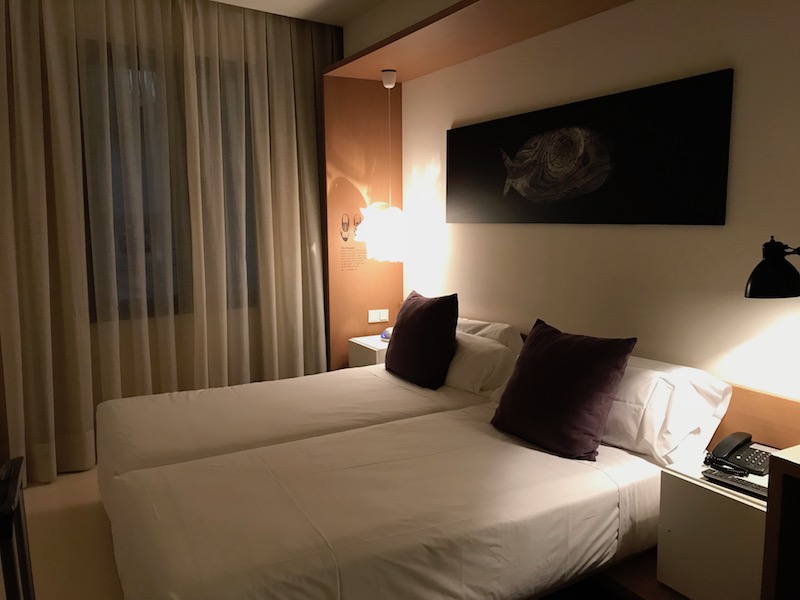
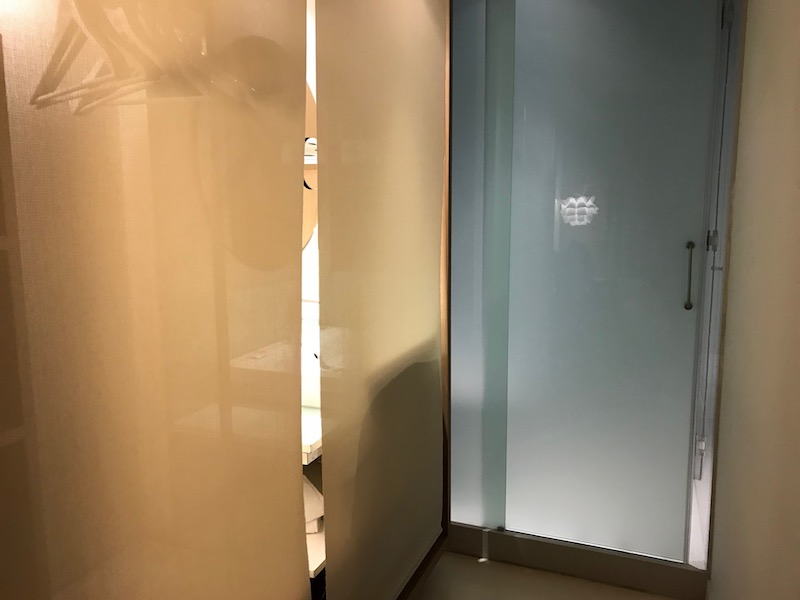
Just around the corner from the hotel was the restaurant that they recommended for lunch, Mil Grito's. It ended up being a great little place for a Tapas lunch to start our Barcelona trip.
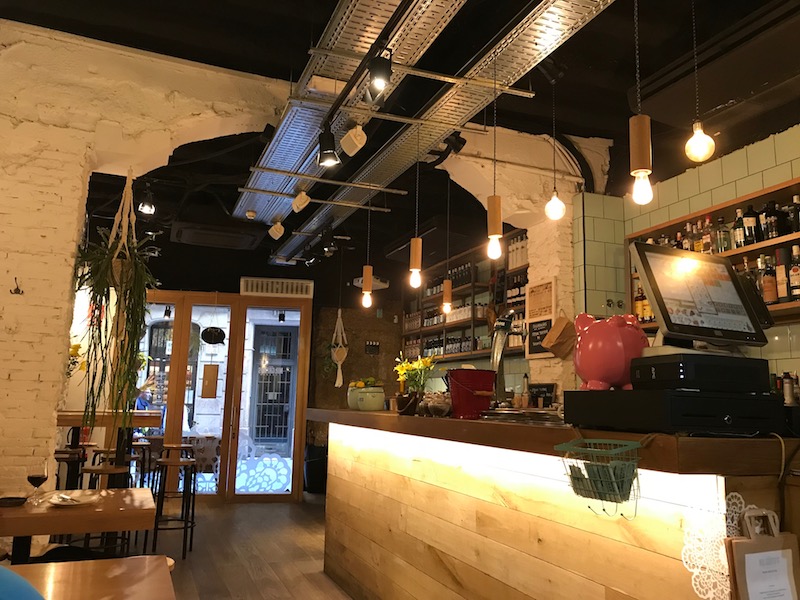

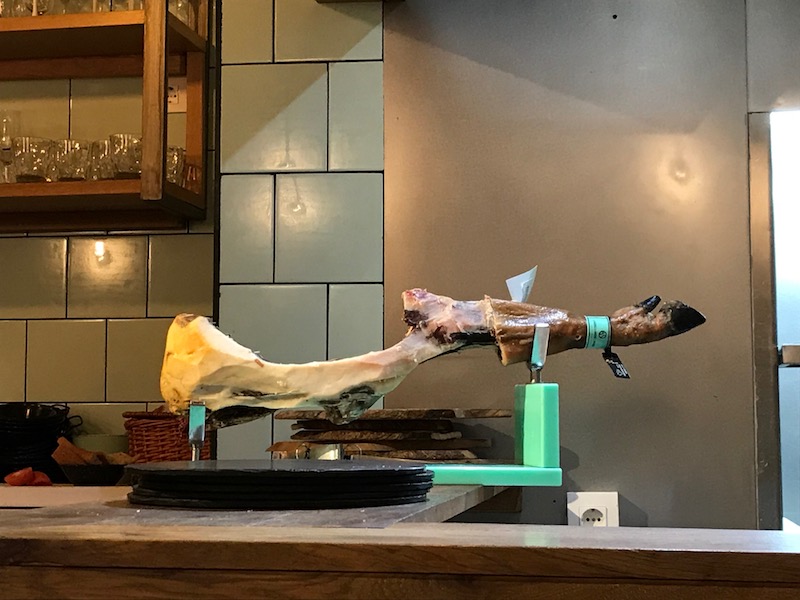
They started us with a free glass of champagne when we showed them the card with the hotel name!
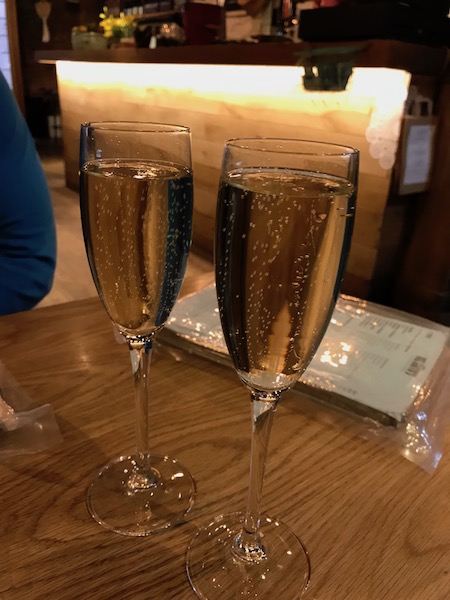
Then our list of Tapas: Iberian acorn-fed ham, Catalan tomato bread, Mil Grito's patatas bravas (which ended up being little potatoes with a tasty sauce through the middle), and the Carasau fitabread with smoked sardines.


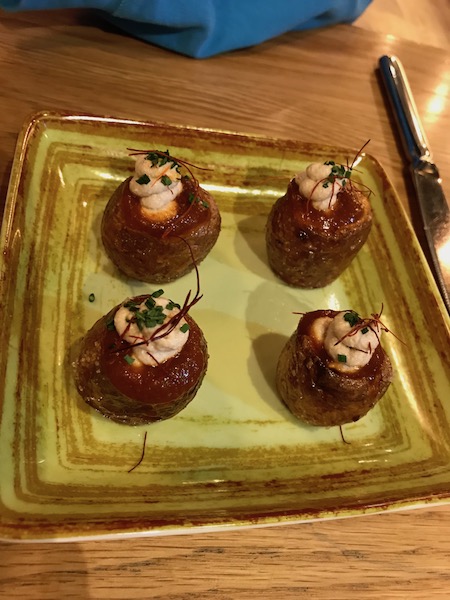

From lunch, we set off on a self-guided walking tour of the Gothic Quarter. Starting near our hotel, Catalonia Square (Plaça de Catalunya) is the main square of Barcelona (the residents think of this as their "Times Square") and is the link between the old city and the new part of the city. It is also where a majority of the anti-government protests are held. The square has several fountains and statues (along with longs of pigeons), and surrounded by huge Art Deco buildings (the style popular in the 1920's when the square was laid out).


The Ramblas forms a boundary between the Gothic Quarter and the El Raval Quarter (and was the site of the 2017 terrorist attack). The tree-lined pedestrian mall runs from Plaça de Catalunya down to Old Harbor (Port Vell), and is actually a set of separately-named segments. The word "Rambla" loosely translate to stream-bed or dry-riverbed and the course of the Ramblas was, in fact, originally a sewer-filled stream. In 1440, the stream was diverted outside of the old city walls and it gradually was turned into a street. Its origins as a watercourse are reflected in the paving design, which appears to ripple like water. We were doing a self-walking tour and so we just walked down a very short way ... we'll do a longer stroll down the Ramblas on another day.

The Royal Academy of Science and Arts, the building is a good example of the Modernisme style that we see everywhere in Barcelona. In general, it takes a modern, functional building and decorate the facade with fancy ornamentation. In the center is the clock which marks Barcelona's official time. Modernisme was very popular in the late 1800's, and adorn's the exterior of "simple, cost-effective, functionally modern" buildings with fanciful medieval decoration.


The Gothic Quarter (Barri Gòtic) is the center of the old city, with many building dating back to medieval times. It includes the remains of the city's Roman wall and several notable medieval landmarks, the medieval Jewish Quarter, as well as several palaces and government buildings. It is basically a labyrinth of tiny streets that were crammed within the medieval city walls.

Heading into the Gothic Quarter, we peeked into Church of Santa Anna. The church was begun in 1141 by the Order of the Holy Sepulchre and is mainly Gothic in style. The cloisters date from the 15th century when the Monastery of Santa Eulàlia was added. In the courtyard (which had bunches of bums hanging out in it) is the first patriarchal cross depicting Saint Anne, which dates from 1300. Inside the church, the Romanesque windows in the presbytery, transept and dome depict scenes from the Book of Genesis. Adjacent to this part of the church is the chapel of the Holy Sepulchre, one of the highlights, where there is an interesting reproduction of a sculpture dating from 1936. In the central nave of the church, you'll be able to see a beautiful example of the austere and elegant Catalan Gothic style. The interesting part here for me was the octagonal wooden roof, which is somewhat unique in churches, as well as the paintings on the underside of the canopy over the altar.






Avinguda del Portal de l'Angel is "the" shopping street in Barcelona. Here you can see two flags out on balconies ... the top one is the Catalonian flag and the one a couple floors lower is the Spanish flag. The buildings on this street are very nice and well-kept, as it should be for a main pedestrian shopping street.



El Quatre Gats (The Four Cats) was inspired by the French cafe "Le Chat Noir" (The Black Cat). The name itself comes from a Catalan expression meaning "only a few people" and rumor has it that when the original owner had mentioned that he wanted to create this lively place, like the one in Paris, that would stay open all night long, they told him "No one will come, it will be just you and four cats". It became a famous hangout in the 1900's for bohemian artists, like Pablo Picasso, who has his first one-man art show here before heading to Paris and becoming famous. The modernist building, called Casa Marti, was designed by Josep Puig i Cadafalch in 1896. If you look at the exterior of the cafe, you would think it was in a medieval castle with pointed arches, windows with stone tracery, and gargoyles.





This fountain has amazing blue-and-yellow tile work around it, added in 1918, which depicts ladies carrying jugs of water. In the 17th century, this was the last watering stop for horses leaving town.


Plaça Nova (New Square) is where the Cathedral of Barcelona is (we'll get to that later). In this large square, there are 7 bronze letters that spell out Barcino, the Roman name for Barcelona. One legend of the name comes from Barça, one of Hannibal's generals who supposedly came through here on his way to attack Italy. Behind the letters are 2 round towers (reconstructed from some original stones) which were the entrance gate of the ancient Roman city. There were 74 of these towers around the old Roman wall, which was 25 feet high and went for about a mile around. Within these walls, about 4,000 Roman's lived. The part that is jutting out from the tower was part of the Roman aqueduct system that carried fresh water from the hillsides around the city into the walls, where it fed the public fountains where locals could draw water.





Inside the walls is the Casa de l'Ardiaca, which was a mansion belonging to the arch-deacon of the Cathedral. It has a carved Renaissance doorway leading to a small courtyard. The courtyard is decorated with lots of bright tiles around the lower portion. We walked up to a terrace and could get some interesting pictures of a small former church, some gargoyles, and the spire from the Cathedral.





Cathedral of Barcelona (officially the Cathedral of the Holy Cross and Saint Eulalia) was constructed from the 13th to 15th centuries, with the principal work done in the 14th century. A cloister, which encloses the Well of the Geese (Font de les Oques) was completed in 1448. In the late 19th century, the neo-Gothic façade was constructed over what was quite a nondescript facade. The roof is notable for its gargoyles featuring a wide range of animals (both domestic and mythical). The cathedral is dedicated to Eulalia of Barcelona, co-patron saint of Barcelona. Legend has it that she was a young virgin who was exposed naked in the public square and a miraculous snowfall in mid-spring covered her nudity. The enraged Romans put her into a barrel with knives stuck in it and rolled it down a street. She was martyred and her body is entombed in the crypt. We just headed by the front today.



Just around the corner is the Monument to Martyrs of Independence. This is an interesting monument that portrays five martyrs who were executed following an attempted uprising against the French troops during the occupation of Barcelona in 1808. The dictatorship of Primo de Rivera culminated with the dedication of a monument to the heroes of the 1809 uprising. It shows the people shortly before their execution at the Citadel, and shows one well-dressed gentleman, two priests, and two commoners. The alabaster relief above it was added in 1941, when it was rededicated following the Spanish Civil War.

Placa Sant Felip Neri is a tiny square in the middle of the labyrinth of the Gothic Quarter. streets of the Gothic Quarter come out into this unexpected spot. It has a little fountain in the middle, the Baroque church of Sant Felip Neri on one side, and a building which once housed the city's shoemakers' and coppersmiths' guilds. You can clearly see the marks left on the front of the church from bombs that were dropped in January 1938, when a fascist bombing raid left 42 people dead, many of them children from the school next to the church.





Carrer del Bisbe (Bishops Street) runs up from the Cathedral. Between the Palace of the Generalitat of Catalonia and the Casa dels Canonges (Canon's House) is a 1928 neo-Gothic bridge known locally as the Pont del Bisbe (Bishop's Bridge).



This is one of the houses that served as the residence of the canons from the 14th century. It was renovated in 1921 by Joan Rubió i Bellver and the facade was decorated with eighteenth-century decorations including peasant ladies, vases and architectural ornaments.

Bishops Street drops you in Plaça de Sant Jaume (Saint James's Square), which is the administrative heart of Barcelona and Catalonia. On one side is the Palace of the Generalitat of Catalonia and directly across the square is the City Hall. The square dates back to Roman times when it was the crossroads of the main streets, Cardo and Decumanus. The Roman forum and Temple of Augustus were here. While you can't see either here now, there are 4 columns of the Temple which have been preserved (you'll see those next). The Catalonia building is the more interesting one, with a statue over the door of Saint George slaying the dragon of oppression (Saint George is the patron saint of Catalonia and you'll see Georges and dragons all over town).





As mentioned before, a Roman Temple existed where Saint James's Square is today. It is called the Temple of Augustus although there is no proof that I can find that actually proves it was a temple to Augustus. However ... the temple was demolished at some point and the ruins not found until the late 19th century. There are 4 columns remaining, which are now displayed in a tiny courtyard of what looks to be an apartment building.



Plaça del Rei (King's Square) is a 14th-century medieval public square in the Barri Gòtic of Barcelona. The square is surrounded by the Palau Reial Major including the Saló del Tinell, the Palau del Lloctinent (Lieutenant's Palace), the 15th-century tower Mirador del Rei Martí ("King Martin's Watchtower"), and the Capella Reial de Santa Àgata (Royal Chapel of St Agatha). On its southern side stands Casa Padellàs (Padellàs's House) a 15th–16th century palazzo moved here stone by stone from Mercaders Street in 1931 and since 1943, has housed the Barcelona City History Museum (MUHBA).



You can go inside to look at the nice courtyard (which I assume is even nicer when the vines are all green and leafy, unlike today). There is a grand staircase to the upper floor with a very nice coffered roof.






One of the things that you can see here is the Capitulations of Sante Fe, signed by Christopher Columbus in 1492. The document states the privileges and conditions under which Columbus was to sail for the proposed expedition to the East Indies, and how any overseas lands that were conquered would be organized.

Plaça de Sant Just is dominated by the entrance to the Església dels Sants Just i Pastor. Above the entrance portal, an enthroned virgin is flanked by a pair of protective angels. It dates from the 14th century although it wasn't finished until the 16th century. They were doing some work (as you can see) but it was still an interesting little church.






One one side of Plaça de Sant Just is a public well, the oldest water source in the city.

Also in the same square is the 18th-century Palau Moxó, an aristocratic town house covered with faded frescoes of angels cavorting among garlands.

Just on the street is a cubby-hole that houses the tiny 16th-century Chapel of Saint Christopher.


Our first dinner in Barcelona this time was at Pla de la Garsa. It was an interesting little restaurant.
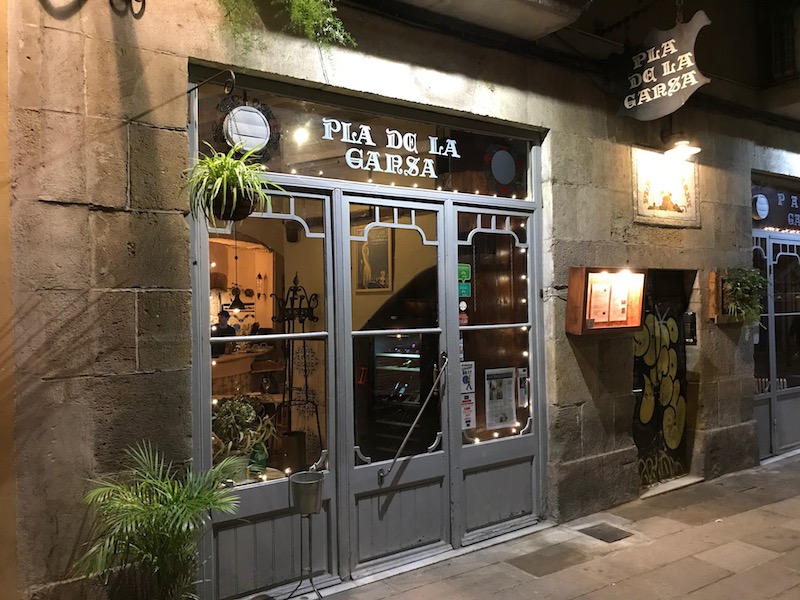

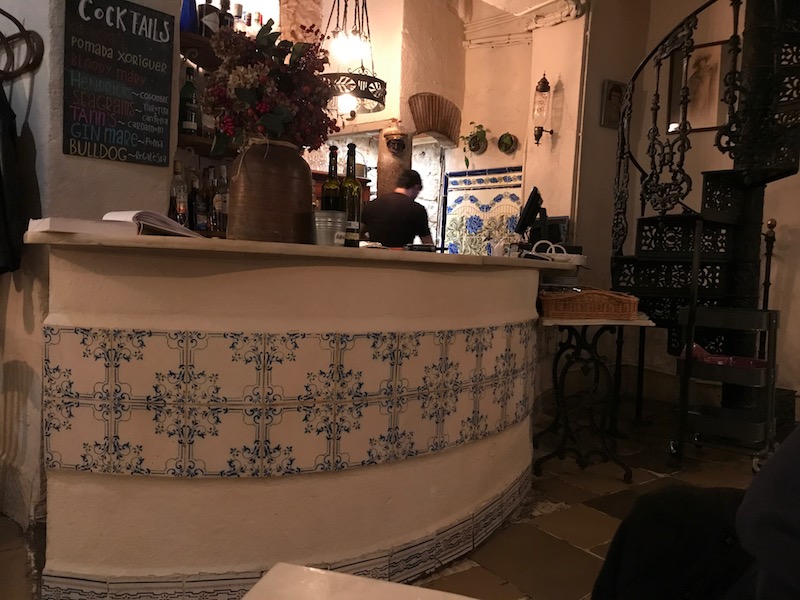




We started with a pitcher of Sangria, which was quite good. We ordered the "Classic Menu", which has several courses that were shared.

First, there was a set of puree's or creams: green olive tapenade, beet hummus, smoked herring and apple cream, and a goat cheese and tomato cream. Tom's favorite was the olive tapenade, and I think mine was the beet hummus. There was also a selection of sausages that came along with it.

Next was a light anchovy cream fondue with various veggies and breads for dipping.

The meat course was cuts of beef cooked in Montsant wine ... somewhat like a beef bourguignon. This was probably the most tender pieces of beef we've had lately!

Then 3 artisanal Catalan cheese, including Garrotxa Bauma goat cheese, Peralada sheep cheese, and a smoked San Simon da Costa cow cheese.

Continue to Day 2 and Montserrat.